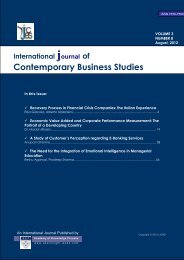International journal of Contemporary Business Studies
International journal of Contemporary Business Studies
International journal of Contemporary Business Studies
You also want an ePaper? Increase the reach of your titles
YUMPU automatically turns print PDFs into web optimized ePapers that Google loves.
<strong>International</strong> Journal <strong>of</strong> <strong>Contemporary</strong> <strong>Business</strong> <strong>Studies</strong><br />
Vol: 3, No: 6. June, 2012 ISSN 2156-7506<br />
Available online at http://www.akpinsight.webs.com<br />
A Review on the Role <strong>of</strong> Managerial Levers<br />
in Innovation Management<br />
Suriati Bt Zainal Abidin 1<br />
Sany Sanuri Bin Mokhtar 2<br />
Rushami Zien Bin Yus<strong>of</strong>f 3<br />
1, 2, 3 College <strong>of</strong> <strong>Business</strong><br />
Universiti Utara Malaysia<br />
06010 UUM Sintok,<br />
Kedah Darul Aman, MALAYSIA.<br />
ABSTRACT<br />
Managerial levers are essential elements to ensure the synchronization<br />
between people and system which would assist in implementing<br />
innovation in the organization. Based on the diverse literature, this paper<br />
reviews five types <strong>of</strong> managerial levers: strategy, organization structure,<br />
resource allocation, knowledge management and organizational learning<br />
and culture. Each lever has its beneficial function to be effectively assist<br />
innovation process. Despite the fact that innovation is a dynamic process<br />
and involved multi-dimensional factors, the role <strong>of</strong> managerial levers is<br />
considered fundamental building blocks that will shape innovation. This<br />
review indicates that managerial levers should be applied side by side in<br />
the innovation management in order to ensure that innovation is establish<br />
and managed efficiently.<br />
Keywords: Managerial Levers, Innovation Management, Innovation<br />
Process,<br />
<strong>International</strong> Journal <strong>of</strong><br />
<strong>Contemporary</strong> <strong>Business</strong> <strong>Studies</strong><br />
Vol: 3, No: 6. June, 2012<br />
pp.6-14<br />
©Academy <strong>of</strong> Knowledge Process<br />
1. INTRODUCTION<br />
Levers are the basic structure <strong>of</strong> any organization and it must be linked consistently to<br />
maximize efficiency (Steward, 2010). It is claimed that seven managerial levers are<br />
needed in order to be a strong company: strategy, structure, leadership, information and<br />
decision processes, people, culture, reward and incentives (Steward, 2010). In a study <strong>of</strong><br />
cultivating new mental space for business innovation, managerial levers act as a<br />
technique that enable organizations to find new opportunity by adapting to rapid changes<br />
(Leibold, Voelpel, & Tekie, 2004). While in a case study <strong>of</strong> 124 companies in USA, it<br />
has shown that structural and skill levers <strong>of</strong> strategy implementation is proven in building<br />
a capable organization (Crittenden & Crittenden, 2008). It has also emphasized that<br />
organization need to have a clear understanding <strong>of</strong> each lever role so that it could really<br />
bring impact on organization ability to succeed (Crittenden & Crittenden, 2008).<br />
Managerial levers facilitate in creating new market or customer, product, service, value chain and<br />
capability space (Leibold, et al., 2004) According to Crossan and Apaydin (2010) managerial levers is a<br />
Copyright © 2012. Academy <strong>of</strong> Knowledge Process<br />
6
















